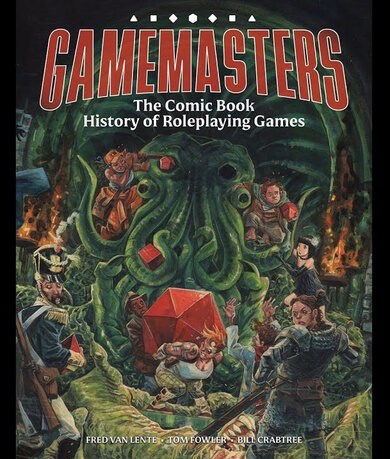We may earn money or products from the companies mentioned in this post.
I know that there are some people who look at an RPG character as nothing more than a transportation device for equipment, but I personally can’t make myself care very much about equipment that isn’t important to the plot or the character. My basic attitude towards character equipment is that if the character needs one, he probably brought one. Because he’s a fucking professional. If it seems really unlikely, the player can always roll for it.
Given my general distaste for tracking arrows and strips of jerky, I initially liked D&D 5’s idea of lumping standard adventuring crap (rations, torches, rope, owlbear erotica) into themed packs of equipment: The Dungeoneer’s Pack, The Explorer’s Pack, The Scholar’s Pack, etc. Seemed like a nice way of making players commit to general theme of nonsense equipment without having to list it out. “Need some chalk? No problem, I’ve got a Dungeoneer’s Pack, so I’m sure I’ve got some. Helps with marking where I’ve been” Right? Of course not. The Dungeoneer’s Pack, like all the other packs, contains a list of very specific items (a backpack, a crowbar, a hammer, 10 pitons, 10 torches, a tinderbox, 10 days of rations, a waterskin, and 50’ of rope). So the packs are basically pointless beyond a possible bulk discount (the description only says the packs “might be cheaper than buying the items individually,” and I’m not doing the math to find out).
So yeah, D&D still demands of list of everything your character is carrying, because nothing says “grand, epic adventure” like torch accounting.
Of course, I’m getting ahead of myself. The chapter actually opens with armor and weapons, because this is D&D. They’re armor and weapons. Other than shields now adding 2 to armor class instead of 1 and a rule about improvised weapons, there’s not much new here. In fact, the list of weapons has been seriously streamlined to things that are mostly recognizable to people who have read a few fantasy novels. Polearm listings in particular have been slashed like mattress prices on Presidents’ Day. While this robs the incoming generation of players of the chance to learn patience, determination, and research skills so they can figure out the differences between a Glaive, a Glaive-Guisarme, a Guisarme, a Guisarme-Voulge, and a Voulge, the simplification does make the game more accessible. Besides, they can probably just look it up now, anyway. I blame Unearthed Arcana and the internet.
Adventuring Equipment is always an interesting part of the Equipment section, and we’ve got some new entries here in the form of Ball Bearings, Hunting Traps, Healing Potions (presumably non-magical, though it’s not really specified), Mess Kits (clearly of the same design we used when I was a Boy Scout), and a few others. Perhaps the oddest thing about the section is what the authors choose to describe, and what they choose to describe about it. There doesn’t seem to be a lot of logic applied here. For example, they describe exactly what they mean by “Hunting Trap” (it’s a bear trap), but Caltrops just get mechanics. Are there really people (presumably a majority of people?) walking around today who consider “caltrop” a standard vocabulary word but are completely baffled by the concept of a bear trap? I’m not sure I believe that.
Then we get to Tools, which we first met in the Character Classes chapter, where some PCs got proficiency with certain types of tools. In the equipment chapter, it becomes clear that Tools are, for all intents and purposes, just a different way of mechanically phrasing skills. And it’s really weird what skills they decide to tie to tool proficiencies. Things like pottery or specific types of vehicles mostly make sense, and I could even see an argument that a musical instrument or navigational charts are so essential to their respective skills that the skill doesn’t exist outside of the tool, but gambling? Really?
Unlike the adventurer’s packs, the exact contents of the tool sets is left vague. With the exception of Thieves’ Tools (which are fully itemized), all of the descriptions either contain a partial list followed by some form of “and some other stuff” or completely lack any indication of what they contain. For example, all the craft skills are lumped into a single “Artisan’s Tools” tool set, so all I know about Smith’s Tools is that they weight 8 pounds and cost 20 gold pieces. Given the weight, I think it’s safe to assume they don’t include a forge or an anvil (unless it’s a really cute teeny-tiny anvil), so what does that leave? A hammer, tongs, and a bucket? Maybe some thick gloves? I know that the reason these kits aren’t itemized is because the writers didn’t want to do the research required to figure it out and most players aren’t going to care, but once you’ve established a “list every piece of chalk” approach to inventory, it’s a little disingenuous to try to pass off an 8 pound bag of alchemy supplies as a single item that doesn’t merit further clarification.
The next few sections get into even fiddlier minutiae, starting with mounts and vehicles, which are framed as nothing more than a way to carry all your other crap, then listing some trade goods for those who want to enjoy the magic of barter, and finally a lifestyle cost for players who just don’t get enough accounting during dungeon crawls and want to track how much their character spends on room and board between adventures. Grand. Epic. Adventures.
The Hireling section does remind me of one thing from the beginning of the chapter that I haven’t mentioned: Unlike in 3E, where magic was just another trade and every town had three magic shops where you could buy a Hand of Vecna and a Wish spells with predictable suggested retail prices, 5E goes back to the idea that magic is something special that you can’t just pick up at the local bodega. Since the sheer D&Dness of D&D already robs magic of a a lot of its magic, it’s nice to see the game ditch the idea that magic is as common and easy to obtain as a nice pair of boots.
The last section, “Trinkets” is the other thing I actually like about this chapter. Every player gets to roll on a table to generate one random thing the character has somehow acquired. The items on the table tend to be some combination of useless, weird, and mysterious: a mummified goblin’s hand, a nightmarish idol that gives you bad dreams, and a glass jar full of lard labelled “Griffon Grease” are just a few examples. While a random table (even one with 100 entries) is kind of limiting in my opinion, the basic idea of “your character has this weird thing, maybe there’s a story behind it” is a good one, especially for newer players who aren’t used to building story hooks into their characters.
Next up is a chapter called “Customization Options,” which looks like it may include some new material.






